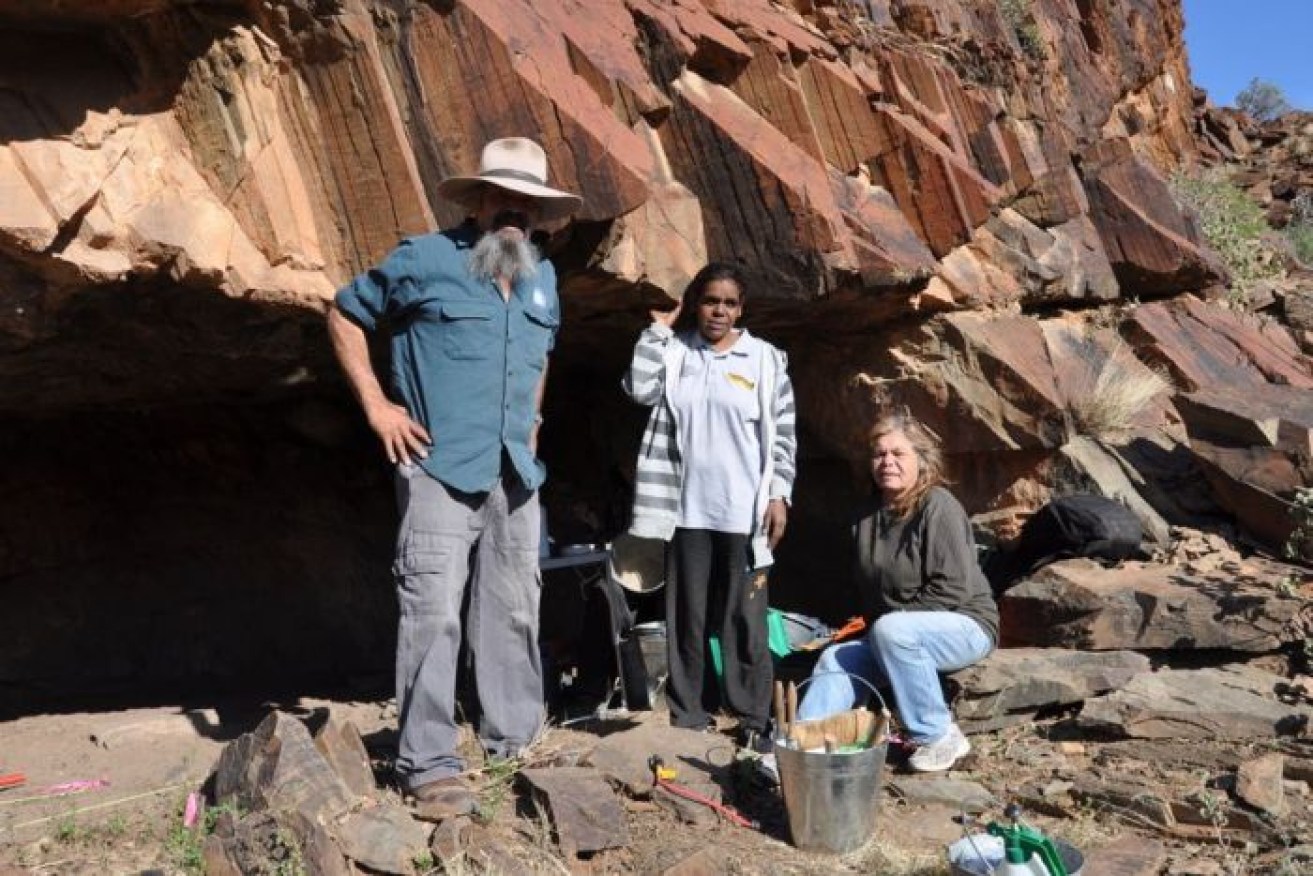Elder on toilet break finds rock shelter, rewrites Aboriginal history

Co-authors Clifford Coulthard and Sophia Wilton with Christine Coulthard of the Adnyamathanha Traditional Lands Association. Photo: ABC
The chance discovery of a rock shelter in the Flinders Ranges has unearthed one of the most important prehistoric sites in Australia.
The site, known as Warratyi, shows Aboriginal Australians settled the arid interior of the country around 49,000 years ago — some 10,000 years earlier than previously thought.
The shelter, about 550 kilometres north of Adelaide, also contains the first reliably dated evidence of human interaction with megafauna.
Artefacts excavated at the site also push back the earliest-known dates on the development of key bone and stone axe technologies and the use of ochre in Australia.
Lead author Giles Hamm, a consultant archaeologist and doctoral student at La Trobe University, found the site with local Adnyamathanha elder Clifford Coulthard while surveying gorges in the northern Flinders Ranges.
“Nature called and Cliff walked up this creek bed into this gorge and found this amazing spring surrounded by rock art,” Mr Hamm said.
“A man getting out of the car to go to the toilet led to the discovery of one of the most important sites in Australian pre-history.”
Mr Hamm said during a survey of the gorge they noticed a rock shelter with a blackened roof about 20 metres above the creek bed.
“Immediately when we saw that we thought, ‘Wow, that’s people lighting fires inside that rock shelter, that’s human activity’,” he said.
At the time they had no idea how significant the find was, Mr Hamm admitted, and thought maybe it would reach back about 5000 years.
Excavations reveal treasure trove of artefacts and bones
Working with the Adnyamathanha people over the past nine years, Mr Hamm and colleagues recovered from the 1m-deep excavations around 4300 artefacts and 200 bone fragments from 16 mammals and one reptile.

Aborigines lived with Diprotodon around 49,000 years ago. Photo: Wikimedia
Importantly, dating of the artefacts and fossil finds shows humans occupied the site from 49,000 to 46,000 years ago.
Mr Hamm said the significance of the site was the combination of its age and geographic location.
The previous oldest-known site in the arid zone, located at Puritjarra in western Central Australia, is around 38,000 years old.
“[This discovery] puts people moving south from the northern part of the continent to the southern interior a lot sooner than we thought.”
However, Mr Hamm said it was likely the climate was more favourable when they arrived.
“They got there before it became really arid,” he said.
“In one sense they were trapped in the Flinders Ranges because once the climate changed [due to the last glacial maximum] it was too risky to move out of these well-watered ranges that had these permanent springs.”

A sharpened bone point, dated to 40-38,000 years old, is oldest bone tool yet found in Australia. Photo: Supplied: Giles Hamm
It was a view supported by palaeoanthropologist Michael Westaway at Griffith University, who was part of a recent genomic study that confirmed modern Aboriginal Australians are the descendants of the first people to inhabit Australia and showed they adapted genetically to survive in the desert.
“Our DNA paper suggested the arid centre at 50,000 years ago was not really a barrier to the movement of people, and this seems to be what Giles is suggesting — people were able to migrate south quite quickly,” Dr Westaway said.
Among the other significant artefact finds at the site was the earliest-known use of ochre in Australia and South-East Asia around 49,000-46,000 years ago.
Mr Hamm said they had pushed back the dates on the development of technologies such as bone needles (40,000-38,000 years ago), wood-handled stone tools (at least 24,000 years ago) and gypsum use (40,000-33,000 years ago).
The site also provided reliably dated evidence of hafted axe technology about 38,000 years ago.
-ABC








